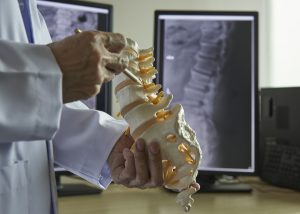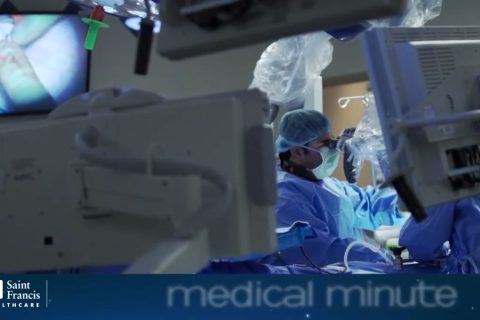What are Spine Disorders?
Spinal disorders are the disturbance of normal functioning of the spinal column and/or spinal cord. Common spine disorders include bulging or ruptured discs, spinal stenosis, and radiculopathy.
Diagnosis
We use several technologies to diagnose spine disorders, including:
- Electromyogram. Electromyogram is a noninvasive procedure used to detect abnormal muscle electrical activity in many diseases and conditions, including muscular dystrophy, inflammation of muscles, pinched nerves, damage to nerves in the arms and legs, amyotrophic lateral sclerosis (ALS, also known as Lou Gehrig disease), myasthenia gravis, disc herniation and others.
- Evoked potentials. Evoked potentials are helpful in evaluating a number of different problems including spinal cord injuries, acoustic neuroma (benign tumor that may develop on the hearing and balance nerves near the inner ear) and optic neuritis (inflammation of the optic nerve causes loss of vision and eye pain).
- Intraoperative Neurophysiologic Monitoring. During surgery electroneurodiagnostic studies are used to monitor and evaluate the electrical activity of the brain and spinal cord.
- Magnetic resonance imaging (MRI). During magnetic resonance imaging (MRI), the body is exposed to electromagnetic radiation that can detect, process and convert images of the body’s soft tissue, such as the brain or spinal cord, into computer images.
- Myelography. This X-ray test is used to examine the spinal cord or help diagnose leg or back problems. This test uses dye that is directly injected into the spinal canal to show areas where the spinal cord is being pinched by vertebrae.
Treatments
Bone Implants
Bone implants are highly effective in relieving pain and improving mobility in people with routine disc disease in the lower back and neck. The bone implants use small wedges of bone milled to fit between two or more spinal vertebrae. The implants help eliminate abnormal motion in the disc space by placing the load along the spine in the way it is intended.
Image-Guided System
The image-guided system used during brain surgery consists of CT and/or MRI scans to provide a clear picture of the area of the brain the surgeon will operate on. This system is so precise the surgeon does not need to look at the actual brain during surgery but rather the computer on which the mapped brain images are enhanced.
Kyphoplasty
Kyphoplasty treats spine fracture complications such as intense pain, posture problems and pressure on the lungs that reduces their capacity. This minimally invasive surgical procedure inflates a special balloon inside the fractured vertebra to expand the bone back to its normal position.
Sacroiliac Joint Fusion: Minimally-Invasive Procedure to Eliminate Back Pain
The sacroiliac, or SI, joints are joints between the pelvic bones and the base of the spine, or sacrum. Minimally-invasive SI joint fusion using the SI BONE system is a highly effective way to reduce or eliminate pain for which, up until a few years ago, there was no good treatment.
More information on Sacroiliac Joint Fusion
Rehabilitation
Aquatic Therapy
Aquatic therapy facilitates basic treatment techniques used in the gym by including the properties of water (buoyancy, resistance, support and warmth) to challenge and strengthen the patient’s balance, coordination, muscle, endurance, range of motion and tone.
Back School
Back School offers a basic introduction to spinal anatomy, proper lifting techniques and body postures, as well as an opportunity for participants to practice these skills.
Neuropsychology Services
As the only provider in the region with both a neuropsychologist and a behavioral psychologist on staff, Saint Francis Medical Center provides expert care for patients suffering from emotional/cognitive problems due to bodily injury. Inpatient rehabilitation staff helps patients develop coping skills, establish appropriate expectations and modify their lifestyle in accordance with any physical limitations to maintain a positive outlook on life.
Occupational Therapy
Occupational therapists and assistants at Saint Francis Medical Center are focused on increasing independence and improving quality of life. This involves developing individualized treatment programs for patients to help them reach goals in regard to the social, emotional and physiological effects of illnesses and injuries, including spinal cord injury, traumatic brain injury, Alzheimer’s disease, stroke, arthritis, multiple sclerosis, amyotrophic lateral sclerosis and dementia. Caregivers also assist patients in restoring daily living activities, such as self-care, work and leisure.
Pediatric Rehabilitation
The specialized pediatric rehabilitation program supports an interdisciplinary team approach to treating communication, physical, social and behavioral needs. Therapists are experienced at keeping children motivated during therapy sessions.
Physical Therapy
Through the use of exercises and applications that promote and restore normal function and development, physical therapists and assistants at Saint Francis Medical Center help patients overcome injuries and other physically debilitating conditions.
Recreational Therapy
Saint Francis Medical Center’s recreational therapy caregivers work with patients to improve skills and provide information needed to ensure successful adjustment into their home or community environment.
Social Work
Social workers at Saint Francis Medical Center meet with the family members of patients to counsel them in regard to lifestyle changes and connect them to community resources to meet patients’ needs.






